|
This church contains the tombs of many members of the House of Savoy, including King Victor (King Victor Emmanuel I of Sardinia), his wife, Queen Maria Teresa, and one of their daughters, Princess Marie Adelaide of Savoy. Also here is the tomb of King Victor's great-grandmother, Anne Marie d'Orléans, Queen of Sardinia, granddaughter of King Charles I and heir presumptive to King James III and VIII from 1715 to 1720; it is through her that the succession to the throne passed to the House of Savoy in 1807.
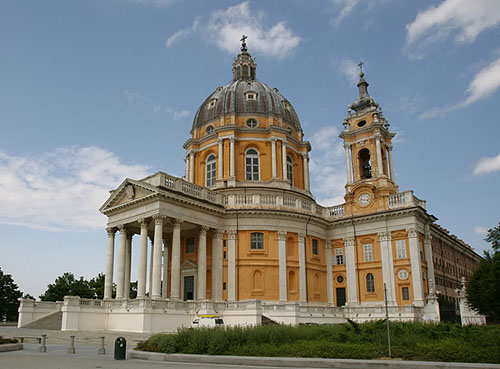
Basilica di Superga, exterior
|
The royal tombs are in the crypt of the church. The guided tour departs from the ticket office and bookstore on the left side of the church. The tour enters the cloister. On the left side of the cloister is the entrance to the crypt. There is a water fountain below a bust of King Umberto I of Italy. To either side is a round bas relief.
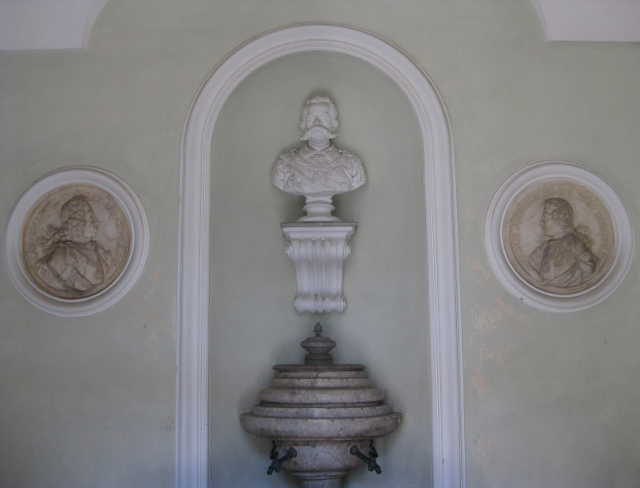
Entrance to the crypt
|
The bas relief on the left shows King Charles Emanuel III of Sardinia, son of Anne Marie d'Orléans. It is marked with a Latin inscription:
CAR · EMANUEL D · G · REX · SAR · CYP · ET IER
Charles Emanuel, by the grace of God, King of Sardinia, Cyprus, and Jerusalem
|

Bas relief of King Charles Emanuel III of Sardinia
|
The bas relief on the right shows the future King Victor Amadeus III of Sardinia, father of King Charles IV and King Victor. It is marked with a Latin inscription:
VICTOR AMADEUS MARIA DUX SABAUDIAE
Victor Amadeus Maria, Duke of Savoy
|
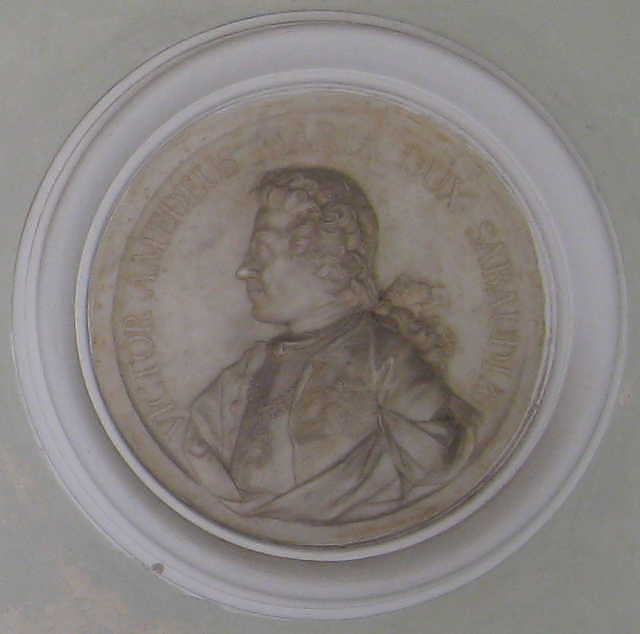
Bas relief of the future King Victor Amadeus III of Sardinia
|
The tour descends a stairwell, goes along a passage, and then turns right into the nave of the crypt, the walls of which are decorated with variously coloured marbles.
On the right wall of the nave of the crypt is the tomb of King Victor set into a semi-circular niche. The monument is made of panels of green marble and red porphyry decorated with gold capitals. In the middle is a Latin inscription in gold letters on white marble. Above the inscription is a pediment decorated with a relief showing armour, flags, and other military motifs. Above the pediment is a small white marble urn on top of which rests a gold crown with a sceptre and a marshal's baton. The Latin inscription reads:
VICTORIVS · EMMANVEL · I
VICTORII · AMEDEI · III · FILIVS
V · SARDINIAE · REX·
PACATA · EVROPA · HAC · INSVLA · REDVX AN · MDCCCXIV
REGNVM · A · KAROLO · EMMANVELE · IV · ABDICATUM
LIGVRIA · ADAVCTVM
PVBLICAM · REM · IVVATVRVS
K · FELICI · SEPTEM · POST · ANNOS · TRADIDIT · SPONTE
NON · PERITVRA · IVSTITIAE · MANSVETVDINIS · PIETATIS
CONSTANTIAE · IN ADVERSIS
TESTIMONIA · RELINQVENS
|
VIXIT · AN LXIV
MENSES · VI
|
REGNAVIT.
AN. XVIII.
|
|
Set at the foot of the monument to King Victor is the tomb of his wife Queen Maria Theresa, a white marble urn with a crown on top. On the front of the urn between two Ionic pilasters is a Latin inscription:
|
QVIETI. MARIAE. THERESIAE. AVSTRACAE.
VXORIS. REGIS. VICTORII. EMMANVELIS
MATRIS. FILIORVM. SEX. QVAE. FORMA. EGREGIA. INGENIO. SINGVLARI. PIA
VIXIT ANNOS. LVII. M. IV. D. XXIX
OBIIT. IANVAE. IV. KAL. APRILIS. ANNO. MDCCCXXXII
|
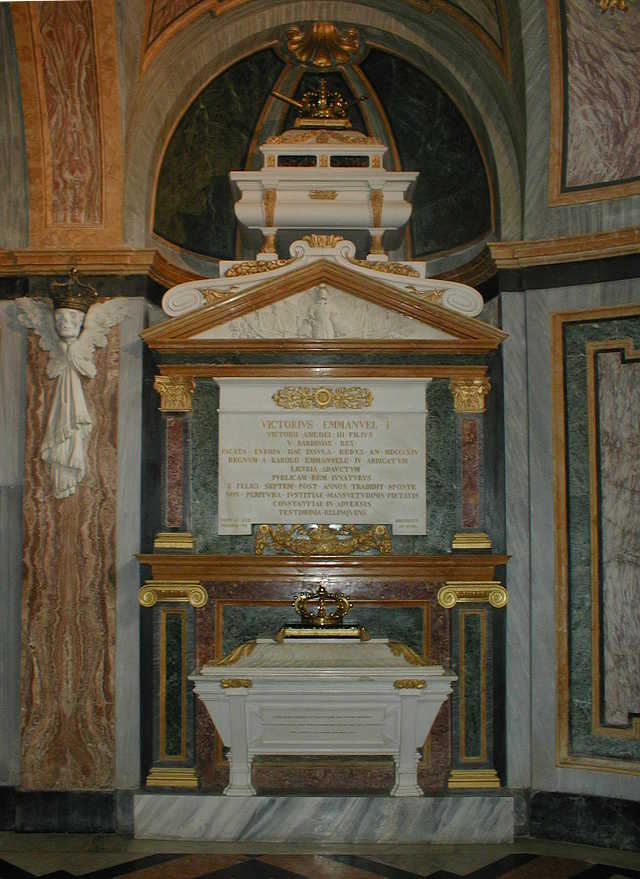
Tombs of King Victor and Queen Maria Theresa
|
Immediately to the left of the tombs of King Victor and Queen Maria Theresa is a monument to King Charles IV (whose tomb is in the Chiesa di Sant' Andrea al Quirinale in Rome). It consists of a white marble panel set in a gold and black frame. Above a Latin inscription is a crown with a sceptre and sword, all set amidst thorn branches. The monument was erected sometime between 1878 and 1900 by King Umberto I of Italy; the Latin inscription reads:
|
CAROLUS. EMMANUEL. IV
VICT. AM. SAB. FILIVS
REX. SARD. CYPRI. ET HIEROS.
RELIGIONE. AC. DOCTRINA. PRAECLARUS
N. AUG. TAURIN. VII KAL. IUNII. A. MDCCLI
OBIIT. ROMAE. PRID. NON. OCT. MDCCCIX
UMBERTUS I. ITAL. REX
NE. HIC. QUOQVE MAIORIS SVI LAUDATISSIMI
DEESSET MEMORIA
P.
|
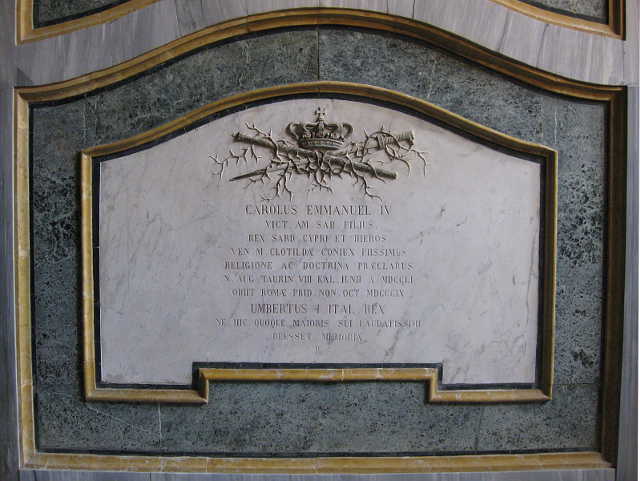
Monument to King Charles IV
|
|
Opposite the monument to King Victor on the left side of the nave is the tomb of his father, King Victor Amadeus III of Sardinia. At the centre is a Latin inscription:
REX · VICTORIVS · AMEDEVS · III
MONVMENTA · REGIBVS · AVO · ET · PATRI · ET · SIBI · VIVVS · FECIT
ITEM · VXORIBVS · ET · LIBERIS · POSTERISQVE
NATVS · AVGVSTAE · TAVR · DIE · XXVI · IVNII · MDCCXXVI
EXTINCTVS · MONTECALERIO · DIE · XVI · OCTOBRIS · MDCCXXVI
REGNVM · GESSIT · A · XXIII · M · VIII · FORTITER · AC · MAGNIFICE
CLARVIT · PLACABILITATE · ET · CLEMENTIA
ALIENISSIMIS · TEMPORIBVS · SALVTI · POPVLI · SVBVENIT
IN · DOCTRINA · RELIGIONIS · ET · DISCIPLINA · MORVM
INSTITVTIONEM · RECTAM · ET · INCOLVMEN · SERVAVIT
|
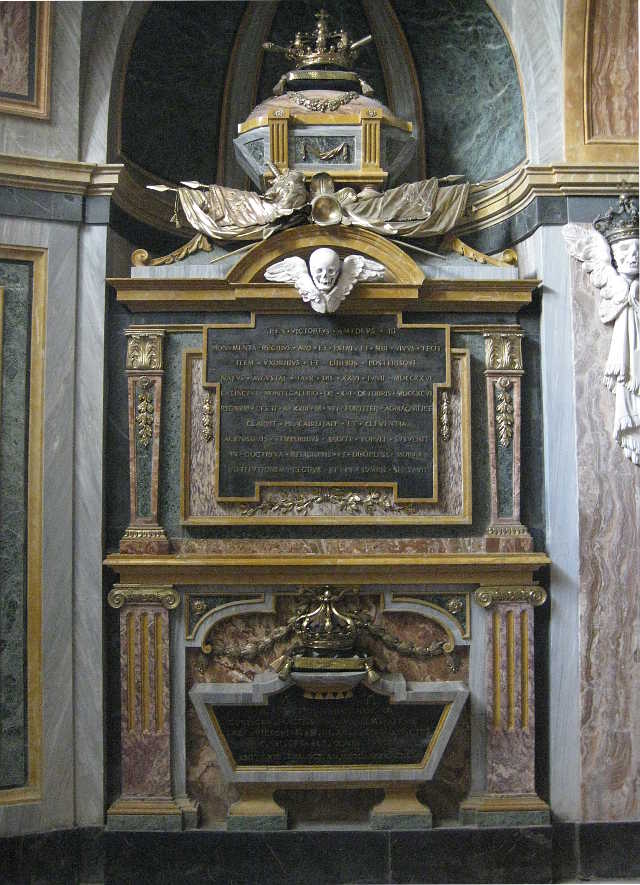
Tomb of King Victor Amadeus III of Sardinia,
father of King Charles IV and King Victor
|
Set at the foot of the monument to King Victor Amadeus III of Sardinia is the tomb of his wife, Queen Maria Antonia Ferdinanda. On the front there is a Latin inscription:
M . ANT . FERDINANDAM . HISP . INF .
CONIVGEM . SANCTISSIMAM . MATREM . PATRIAE
REX . VICTORIVS . AM . III . AD . LVCTVM . RELICTVS
HIC . VBI . OPTABAT . CONDI . IVSSIT
OBIIT . XIII . KAL . OCT . AN . MDCCLXXXV . AET . S . LVI
|
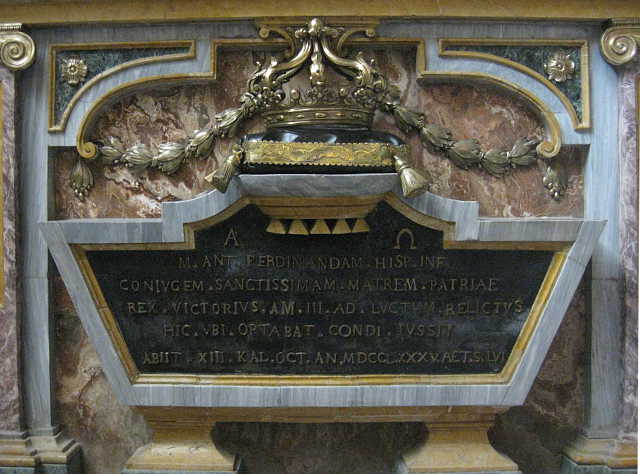
Tomb of Queen Maria Antonia Ferdinanda of Sardinia,
mother of King Charles IV and King Victor
|
To the right of the tombs of King Victor Amadeus III of Sardinia and Queen Maria Antonia Ferdinanda is a monument to their son, the younger brother of King Charles IV and King Victor, King Charles Felix of Sardinia and his wife Queen Maria Christina; their mortal remains are buried at the Abbey of Hautecombe, now in France. There is a Latin inscription:
SACRVM · ANNIVERSARIVM
AD · EXPIATIONEM · PIORVM · MANIVM
CAROLI · FELICIS
REGIS · OPTIMI
AD · ARAM · HVIVS · CRYPTAE
QVA · REGNVM · SARDINIAE · CORPORA
INFERVNTVR
MARIA · CHRISTINA · BORBONIA · AVGVSTA
VIDVA · EIVS · INSTITVIT
IMPERIVM · MAGNO · SPLENDORE · GESSIT · ANNOS · DECEM
DECESSIT · TAVRINI · V · KAL · MAIAS · A · MDCCXXXI
ET · AD · BASILICAM · ALTACVMBANAM · APVD · ALLOBROGES
QVAM · INSTAVRAVERAT
SICVTI · IVSSERAT · DELATVS · EST
|
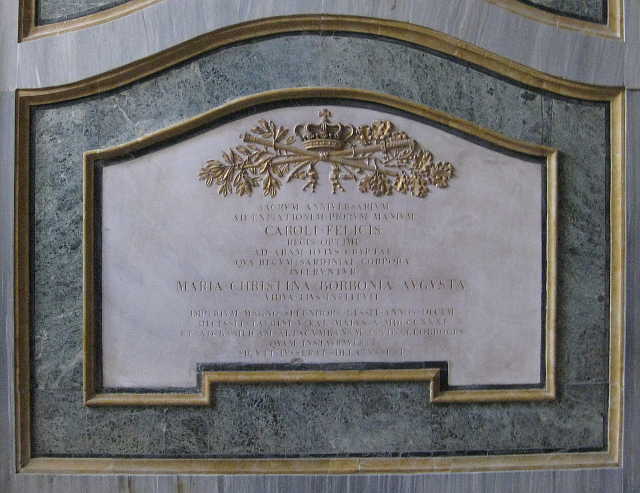
Monument to King Charles Felix of Sardinia,
brother of King Charles IV and King Victor,
and to his wife Queen Maria Christina
|
In the centre of the nave stands a monument which now serves as the tomb of King Charles Albert of Sardinia. It was originally the tomb of King Charles Emanuel III of Sardinia, son of Anne Marie d'Orl&eacte;ans. When his son, King Victor Amadeus III, died in 1796, his mortal remains were placed in the monument and those of his father were moved to the right transept. When King Victor died in 1824, his mortal remains were placed in the monument and those of his father were moved to the left wall of the nave. At that time a Latin inscription was placed on the monument (it has since been removed):
REGI VICTORIO EMMANVELI
PRAEMIA VIRTVTIS ET MERITORVM AETERNA
QVOTIDIANIS PRECIBVS A DEO FLAGITAMVS
DEPOSITVS DIE XIV JAN. MDCCCXXIV
|
When King Charles Albert of Sardinia died in 1849, his mortal remains were placed in the monument in the centre of the nave and those of King Victor were moved to the right wall of the nave.
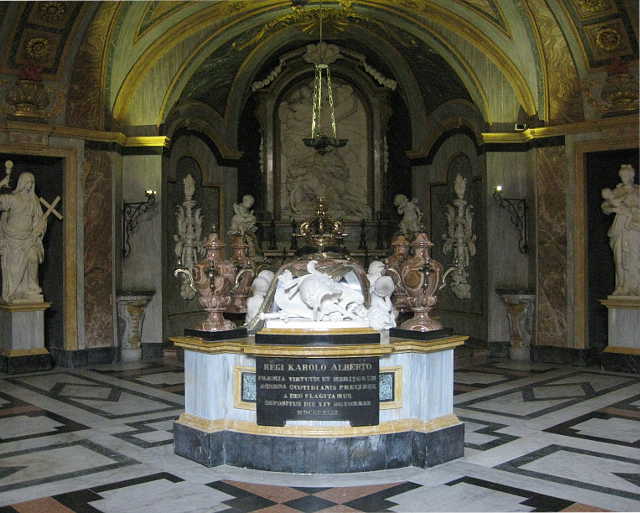
Nave of the crypt
|
The tour continues in the left transept of the crypt. At the far end is the tomb of King Victor Amadeus II of Sardinia, husband of Anne Marie d'Orléans. To the right of the tomb of King Victor Amadeus II, at ground level, is the tomb of his wife Anne Marie d'Orléans.
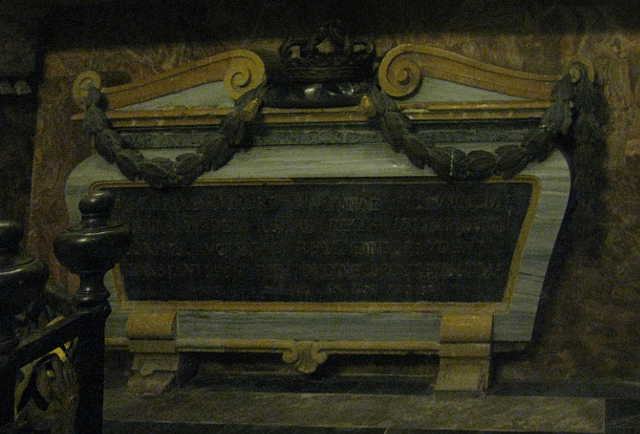
Tomb of Anne Marie d'Orléans,
granddaughter of King Charles I
|
To the left of the tomb of King Victor Amadeus II of Sardinia is a room with the tombs of many members of the House of Savoy who died in childhood. Here is the tomb of the second daughter of King Victor, Princess Marie Adelaide of Savoy (1794-1795). It bears the following Latin inscription:1
|
MARIA. ADELAIDA
CLOTILDA. CAROLA
VIXIT. MENS. X. TANTVM
CAELO. RECEPTA. KAL. AVG. MDCCXCV
CVM. PATER. EIVS. VICT. EMMANVEL. REGIS. FILIVS
ESSET. SEGVSII. IN PROCINCTV
|
|
Also in the children's room are the tombs of four siblings of King Charles IV and King Victor - Amedeo, Duke of Montferrat; Princess Maria Cristina of Savoy; Princess Maria Elisabetta of Savoy; and Maria Anna, Duchess of Chablais - as well as their great-grandparents - King Victor Amadeus II of Sardinia and his wife Anne-Marie d'Orléans (granddaughter of King Charles I).2
The tour returns through the central nave and passes into right transept. At the far end is the tomb of the grandfather of King Charles IV and King Victor - King Charles Emanuel III of Sardinia. The tomb was designed by Simone Duguet and completed in 1786 with statues sculpted by Ignazio and Filippo Collino.3 Above the sarcophagus is an oval bas-relief portrait of Charles-Emanuel held by the male allegorical figure of "Military Genius" with wings and a helmet. At the left is seated the female allegorical figure "Prudence". At the right is seated the male allegorical figure "Valour".
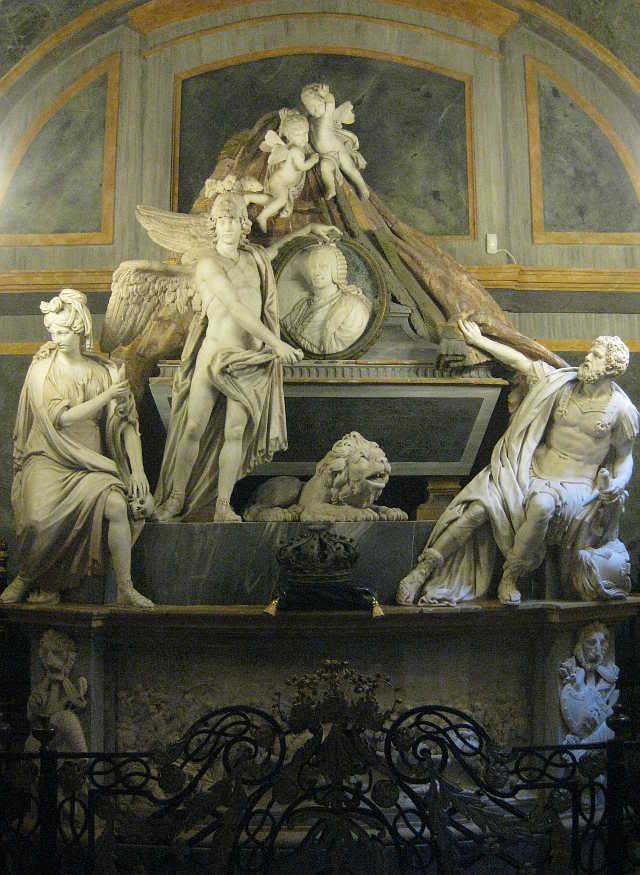
Tomb of King Charles Emanuel III of Sardinia,
grandfather of King Charles IV and King Victor
|
To the left of the tomb of King Charles Emanuel III of Sardinia are the tombs of his three wives. At the top is the tomb of his first wife, Anne Christine Luise, Countess Palatine of Sulzbach (with a prince's crown since she died before her husband became king). At the bottom is the tomb of his third wife, Polyxena Christina of Hesse-Rotenburg-Rheinfels, grandmother of King Charles IV and King Victor.
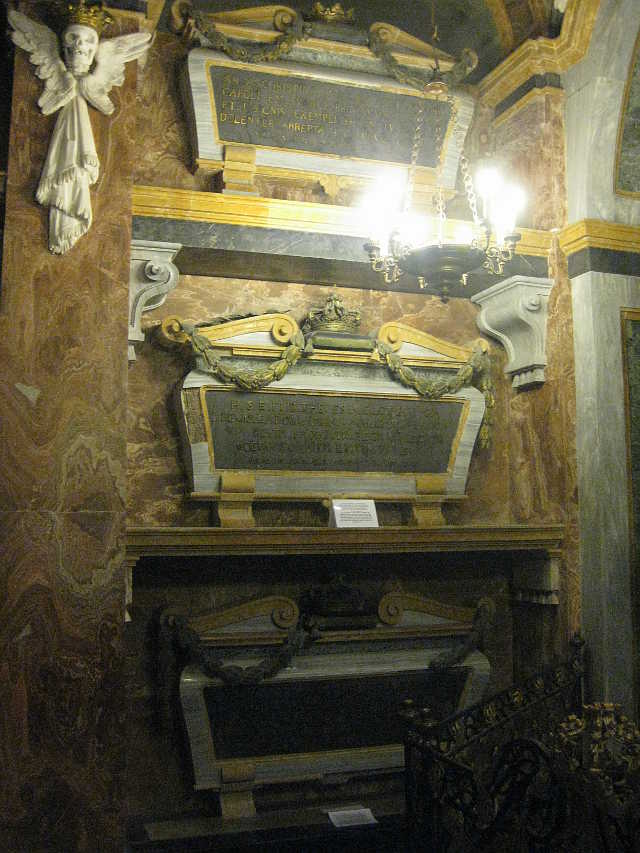
Tombs of the wives of King Charles Emanuel III of Sardinia
|
As the tour leaves the crypt and climbs the stairs back to the cloister, one can see a bust and memorial to King Victor Amadeus III of Sardinia.
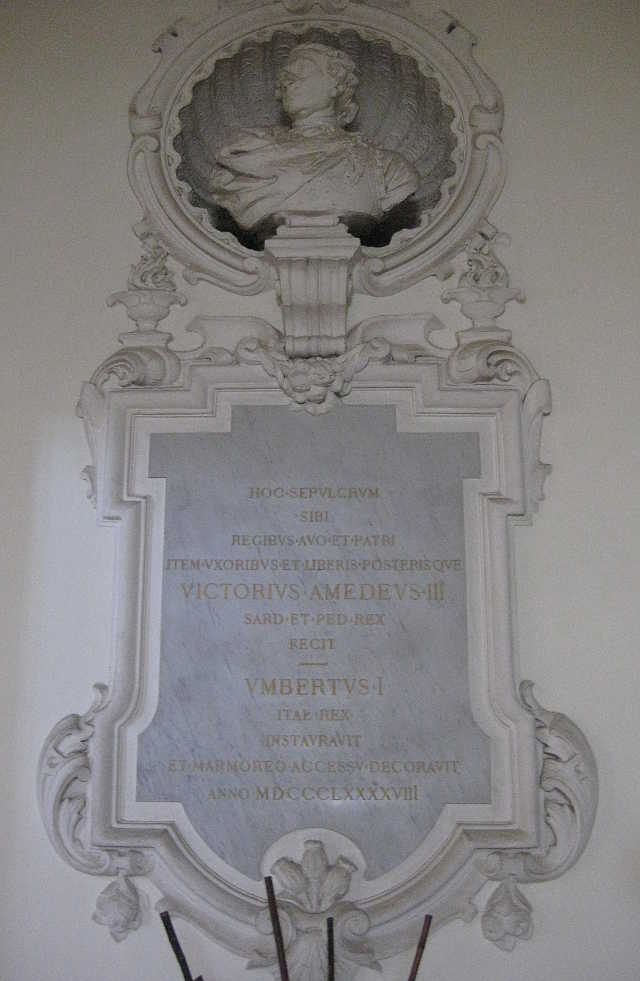
Bust and memorial to King Victor Amadeus III of Sardinia
|
The tour continues in the royal apartment which was used by the Royal Family when they visited the basilica. The main entrance to the apartment (not used by the tour) is a grand staircase with the busts of four Savoys. On the left is a bust of King Victor.
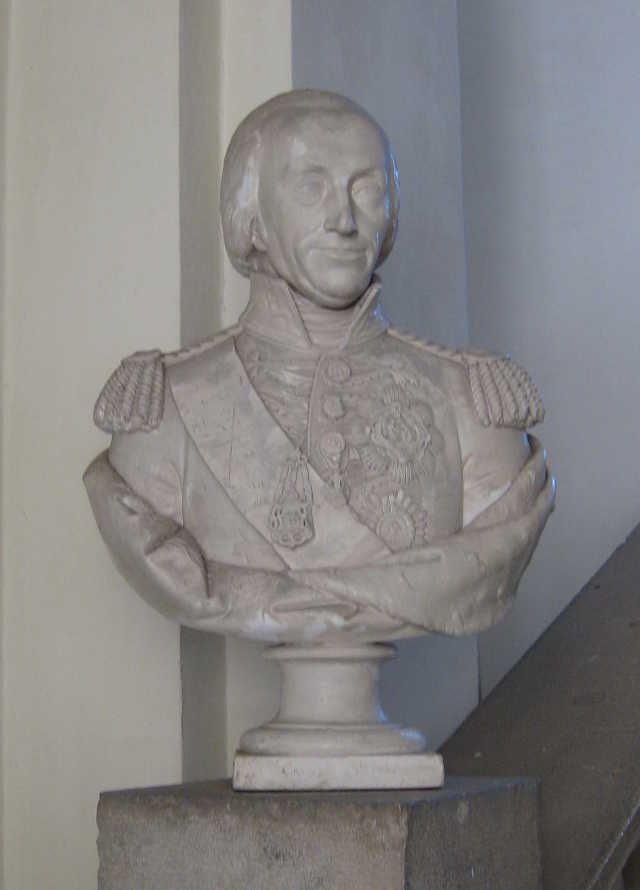
Bust of King Victor
|
Twenty minute guided tours of the royal tombs take place from late March to late September, from 9.30 a.m. to 12.15 p.m. and from 2.30 p.m. to 6.15 p.m.; late September to late March, from 10.00 a.m. to 12.00 noon and from 3.00 p.m. to 5.00 p.m. Closed Fridays, January 1, Easter, June 16 to 30, September 8, and Christmas.
The basilica is located in the Parco Naturale di Superga in the hills to the north-east of the city centre. Take tram 15 to Stazione Sassi, and then bus 79 to Piazza Basilica di Superga.
Notes
1 Augusto Telluccini, "La Real Chiesa di Soperga: ricerche storiche e documenti inediti", Miscellanea di Storia Italiana, terza serie, XV (XLVI della raccolta), 116.
2 Telluccini, 115-119.
3 Ignazio Collino was born in Turin in 1724 and died in the same city in 1793. His brother Filippo Collino was born in 1737 and died in Turin in 1800.
Image 1 (Basilica di Superga, exterior): http://greatriftvalley.blogspot.com/2007/06/torino.html.
Image 2 (Entrance to the crypt): © Noel S. McFerran 2015.
Image 3 (Bas relief of King Charles Emanuel III of Sardinia): © Noel S. McFerran 2015.
Image 4 (Bas relief of the future King Victor Amadeus III of Sardinia): © Noel S. McFerran 2015.
Image 5 (Tombs of King Victor and Queen Maria Theresa): © Noel S. McFerran 2006.
Image 6 (Monument to King Charles IV): © Noel S. McFerran 2015.
Image 7 (Tomb of King Victor Amadeus III of Sardinia): © Noel S. McFerran 2015.
Image 8 (Monument to King Charles Felix of Sardinia): © Noel S. McFerran 2015.
Image 9 (Nave of the crypt): © Noel S. McFerran 2015.
Image 10 (Tomb of Anne Marie d'Orléans): © Noel S. McFerran 2015.
Image 11 (Tomb of King Charles Emanuel III of Sardinia): © Noel S. McFerran 2015.
Image 12 (Tombs of the wives of King Charles Emanuel III of Sardinia): © Noel S. McFerran 2015.
Image 13 (Bust of King Victor): © Noel S. McFerran 2015.
|
|























